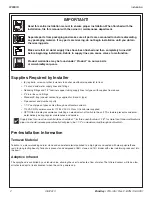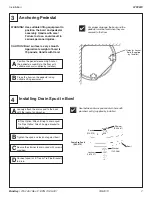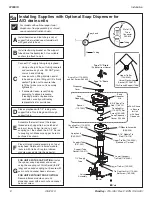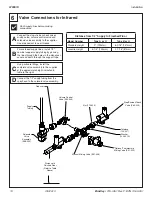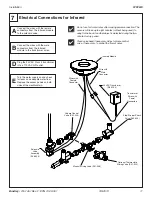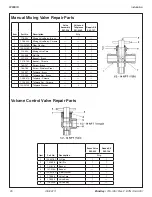
Installation
WF2613
Bradley
•
215-1451 Rev. F; ECN 13-00-001
3/5/2013 13
Cleaning and maintenance instructions for Terrazzo
Clean terrazzo washfountain bowls daily or as often as conditions require with any standard household detergent, hot water and
soft cloth. Bradley terrazzo bowls may be refurbished by cleaning with tri-sodium phosphate, two pounds per gallon, and a scrub
brush. Stubborn spots may be removed with emery cloth. After bowl is thoroughly cleaned and dried, Epoxy resin or a good quality
polyurethane finish should be applied. Eroded terrazzo is usually the result of exposure to caustic substances. This condition can
be repaired relatively easily. Repair kits are available from your Bradley Representative. Do not use drain cleaners on terrazzo.
Cleaning and maintenance instructions for stainless steel
Material Description: Stainless steel is extremely durable, and maintenance is simple and inexpensive. Proper care, particularly
under corrosive conditions, is essential. Always start with the simplest solution and work your way toward the more complicated.
Routine cleaning: Daily or as often as needed use a solution of warm water and soap, detergent, or ammonia. Apply the cleaning
solution per the manufacturer’s instructions and always use a soft cloth or sponge to avoid damaging the finish.
Stubborn Stains: To remove stains from stainless steel use a stainless steel cleaner and polish such as Ball
®
stainless steel
cleaner or a soft abrasive. Always follow the manufacturer’s instructions and apply in the same direction as the polish lines.
NOTICE! Never use ordinary steel wool or steel brushes on stainless steel. Always use stainless steel wool
or stainless steel brushes.
Special Situations for Material
Fingerprints and Smears: To remove fingerprints or smears use a high quality stainless steel cleaner and polish in accordance
with the manufacturer’s instructions. Many of these products leave a protective coating that helps prevent future smears and
fingerprints.
Grease and Oil : To remove grease and oil use a quality commercial detergent or caustic cleaner. Apply in accordance to the
manufacturer’s instructions and in the direction of the polish lines.
Precautions: Avoid prolonged contact with chlorides (bleaches, salts), bromides (sanitizing agents), thiocyanates (pesticides,
photography chemicals, and some foods), and iodides on stainless steel equipment, especially if acid conditions exist.
NOTICE! Do not permit salty solutions to evaporate and dry on stainless steel.
The appearance of rust streaks on stainless steel leads to the belief that the stainless steel is rusting. Look for the actual source
of the rust in some iron or steel particles which may be touching, but not actually a part of the stainless steel structure.
NOTICE! Strongly acidic or caustic cleaners may attack the steel, causing a reddish film to appear. The use
of these cleaners should be avoided.
Brand Names: Use of brand names is intended only to indicate a type of cleaner. This does not constitute an endorsement, nor
does the omission of any brand name cleaner imply its inadequacy. Many products named are regional in distribution, and can be
found in local supermarkets, department and hardware stores, or through your cleaning service. It is emphasized that all products
should be used in strict accordance with package instructions.
Drain Cleaning
Drains can be cleaned with a plumbers snake inserted through the drain spud after removing the strainer, or through the trap
clean out plug.
IMPORTANT!
Do not put drain cleaners in bowl. Damage to bowl will result.


